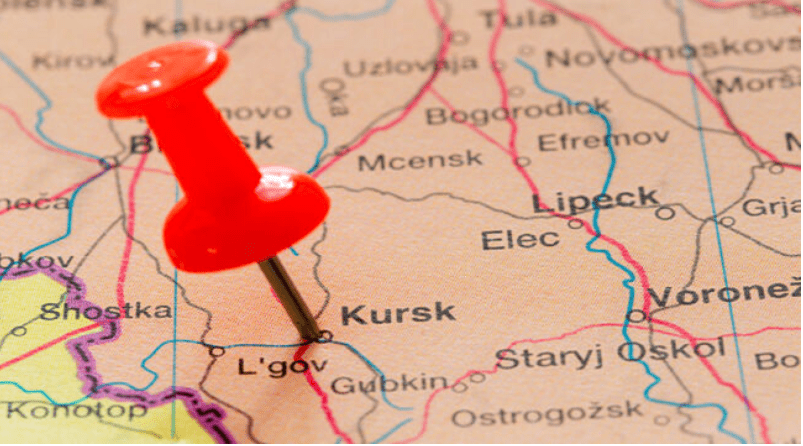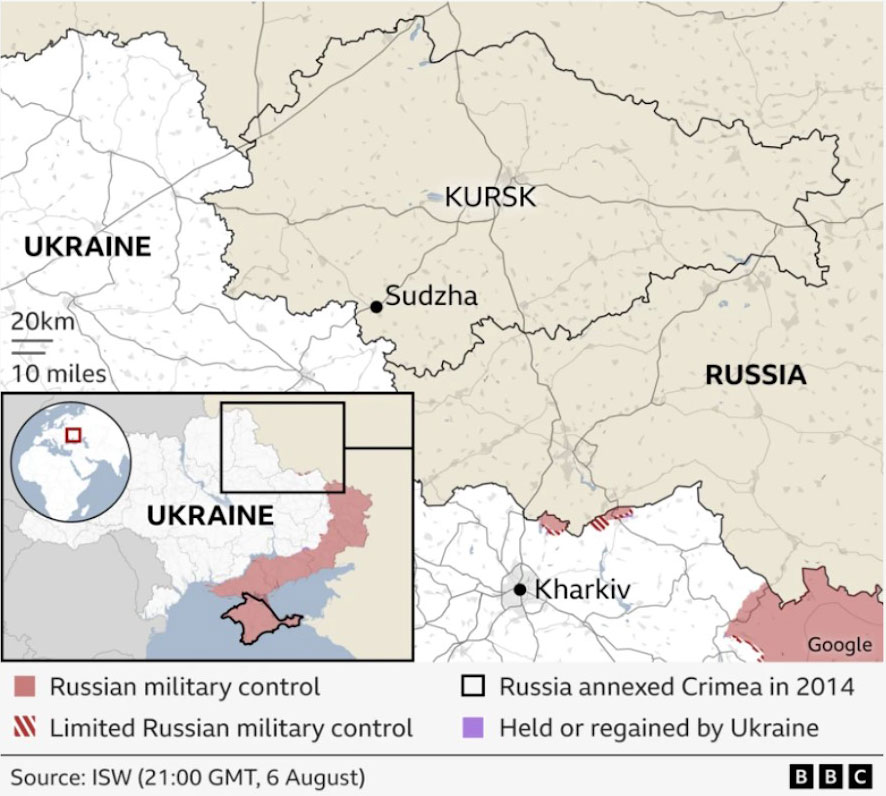What the Heck Was Zelenskyy Thinking?
Guest Post by Byron King

Last week, Ukraine launched an incursion into Russia proper, in the Kursk region (WWII historians are well aware of Kursk).
Previously, Ukraine had not sent large-scale forces across the border into Russia proper.

Map of Kursk region, courtesy of BBC.
Ukraine sent in as many as six (likely understrength) brigades, supported by tanks and armored vehicles.
Let’s get real, though: That’s not anywhere enough to invade Russia. (Ask Napoleon.) And this was how far? A few miles?
The attack has already bogged down.
Meanwhile, how will Ukraine keep its troops and vehicles supplied with fuel, ammunition, food and other supplies? And considering that this is a combat action, what of medical evacuation of the wounded?
Yeah, right; good luck.
Frankly, it’s difficult to see any military logic to this Ukrainian incursion, other than to grab headlines for a few days with a tactical PR stunt. But even Western media is questioning the point of it all.
At higher levels of military thought, what’s the operational method here? What’s Ukraine’s goal, other than to send troops on a suicide mission, kill some Russians and lose a bunch of irreplaceable equipment?
There’s a lot of speculation that Ukraine intended its forces to seize a Russian nuclear power plant near Kursk; but from the map it’s a long reach, about 75 miles away.
I’ve seen other speculation that Ukraine’s move might force Russia to shift troops away from other areas of the current front lines in the southeast. Well, no, because Russia has nearly half a million combat troops — yes, an entire other army — in reserve positions scattered across the western part of the country, not currently engaged with Ukraine along the lines of contact.
And as for strategic effect? Well, not to put too fine a point on things, but this Ukrainian attack is in the order of magnitude of zero. It changes nothing and looks kind of foolish in the process.
At strategic levels, the outcome of this Russia-Ukraine conflict is already decided. Russia has far more people than Ukraine and can raise a much larger army. Russia has more and better military systems: tanks, artillery, etc.
And Russia’s logistics effort is right next door, based on internal lines of communication, well-developed road and rail corridors and well-practiced military hierarchies that date back to the Crimean War of the 1850s.
At every level, Ukraine’s incursion into Kursk is a doomed mission. The soldiers will be killed or captured, and the equipment will wind up in Russian war museums.
Indeed, for Ukraine the war is over except for all the fighting and dying. Although it’s fair to ask, if the war is “over,” then why isn’t it yet finished? How do things conclude?
Well, all in due time.
Below, I show you the Russian art of war, and how it differs from the U.S. approach to fighting wars.
Can the U.S. model survive in today’s new environment? Read on.
By Byron King
With over a thousand years of history behind them, Russians definitely know a few things about fighting wars on their own territory. (Recall Vladimir Putin’s long explanation of Russian history to Tucker Carlson during that famous interview this past winter.) Indeed, Russians have a distinct mindset towards warfare, certainly versus the U.S. approach.
In general, the U.S. way of doing war is what’s called “expeditionary.” That is, pack up the Army, load it onto the Navy (or more recently onto Air Force transport) and send it faraway to fight, all with a very long and expensive logistics train.
Think of the Spanish-American War, World War I, World War II, Korea, Vietnam, the Cold War in Europe and serial wars in the Middle East since the 1990s. The fronts and the fighting were always somewhere else, not here at home.
But Russia is different. Per geography and history, Russia approaches warfare in what’s called a “continental” sense. That is, historically, war has always come to Russia, specifically via people from the west who marched east: from Sweden in the 1700s, Napoleon and France/Western Europe in the 1800s, Germany in the 1900s.
Deep in their collective national memory, Russians understand that they must remain vigilant to outside threats, certainly from the west. And as historical cycles unfold, Russians constantly prepare to fight on their home turf.
For example, in March 2014 Russia justified its seizure of Crimea because: a) Crimea has been part of Russia since 1783, via a treaty with the Ottoman Empire; and b) Ukraine was setting up a NATO base in the old Russian port of Sevastopol. In other words, Russia wanted back its historical lands, and the trigger point was a clear military move by NATO.
Closer in time, Russia’s invasion of Ukraine in February 2022 was not based on some sort of ethnic dislike of that country or its people.
Instead, Russia was alarmed that Ukraine had clearly become a de facto arm of NATO, which is an unallowable military threat to Moscow. Think like a Russian and this is not that hard to figure out.
Looking back over the past 30 months, anyone who paid attention has had a daily, close-up look at the current Russian “way of war.” And no, it’s not flashy or grand, but instead careful and methodical.
Characteristically, Russia’s military doctrine focuses on destroying the enemy via massive firepower, artillery, armor and aviation. And this combat capability is based, in turn, on a militarily productive Russian economy rooted in minerals, mines, energy, basic industry, heavy machine building; all that, plus a superb, national-scale education system that turns out large numbers of people suitable to the cause. (Long story.)
In other words, Russian military power is the first derivative of Russia’s national energy and industrial economy.
A Purposeful, Methodical Grind
Of course, Russia has taken casualties in its Ukraine operation, and cemeteries across Russia are filled with recently dug graves. But overall, from the general staff in Moscow to the front-line rifle squad in the field, everything Russia does is militarily purposeful.
One sees no PR stunts from the Russians.
In recent months, the statistics are that Russia has methodically eliminated about 1,800–2,200 Ukrainian troops per day (KIA or seriously wounded). Over the past 30 months, Ukrainian dead are easily in the half million range, and likely more.
Also, every day Russia destroys about one–two dozen Ukrainian tanks and other armored systems, while Ukraine’s air force is all but grounded because Russian air defense and aerospace forces control the sky.
All this while Russian electronic warfare dominates the spectrum.
Add in the fact that with modern surveillance and communication systems Russia can identify elements of interest and hit them with a targeting loop that is eye-wateringly fast. If they see you, you die; think in terms of five, 10, 15 minutes.
Over and above her legendary artillery fire for effect, Russian cruise missiles and hypersonic systems are such that, in terms of range and speed, Ukraine has no operational depth.
That is, nothing in Ukraine is safe behind the front lines, no matter the distance, all the way west to the Polish border; and the only reason that Russia has not (yet) struck “Ukrainian” targets in Poland is Russia’s political restraint.
Along these lines, and to return to Ukraine’s recent incursion into the Kursk area I’ve seen reports that Russia recently dropped two ballistic missiles onto the main command post of the Ukraine incursion. This attack killed the four top Ukrainian commanding generals, and about 75 others. Or so go the rumors.
Meanwhile, I’ve seen video and read accounts of Russian drone swarms at the scale of hundreds and even thousands at a time, whizzing across the sky like a flock of passenger pigeons of old.
On the U.S. end and based on public comments by senior military and civilian officials, analysts are shocked at what’s happening on the front lines. Post Cold War, and now at the end of a 35-year holiday from thinking in terms of history and strategy, the U.S. military has little to no workable doctrine with which to confront this kind of “peer” adversary, namely Russia.
Per numerous public accounts, the U.S. military — all services, plus senior echelons in the Department of Defense — have all but torn up the doctrine and warfighting books from the past three decades of war in the Middle East.
The prospect of fighting Russia now is a far stretch from the good old days of beating the tar out of third-rate military forces like those of former Iraq. That entire era, bookmarked by one after another of distant, expensive Middle East wars, was based on ephemeral moments in time, all of which have passed us by.
In fact, across the Middle East today, where large contingents of U.S. forces remain stationed, U.S. military and political players routinely perform a careful dance not to engage “too much” against Iran, lest the Iranians shoot back. Look at the current political-military tap dance happening between Iran and Israel.
Meanwhile, don’t overlook recent engagements with the Houthis in Yemen, who proved that they could block the southern entrance of the Red Sea when and how they chose to do so.
According to U.S. officials, the entire — still ongoing — episode was the largest sustained combat effort at sea for the Navy since WWII. And in terms of just missiles and bombs in the ready locker, U.S. forces are playing with a weak hand.
Wake Up!
What’s the way ahead for America, in a world where the old ways of waging war have changed so dramatically?
Well, it begins with paying attention to and seeing the reality behind the political lies and smokescreens. Our American political class comes across as mostly clueless, if not staggeringly ignorant. The welfare-state defense budget is its own story, with lots of money going to things that have not won wars in a long time.
At the cultural level, a cynic might say that U.S. schools and universities do a terrible job of teaching military history; and this is for a reason, which is to keep almost everyone unschooled and unable to understand even the basics of what they can see on a video screen.
But that’s a whole other story.





